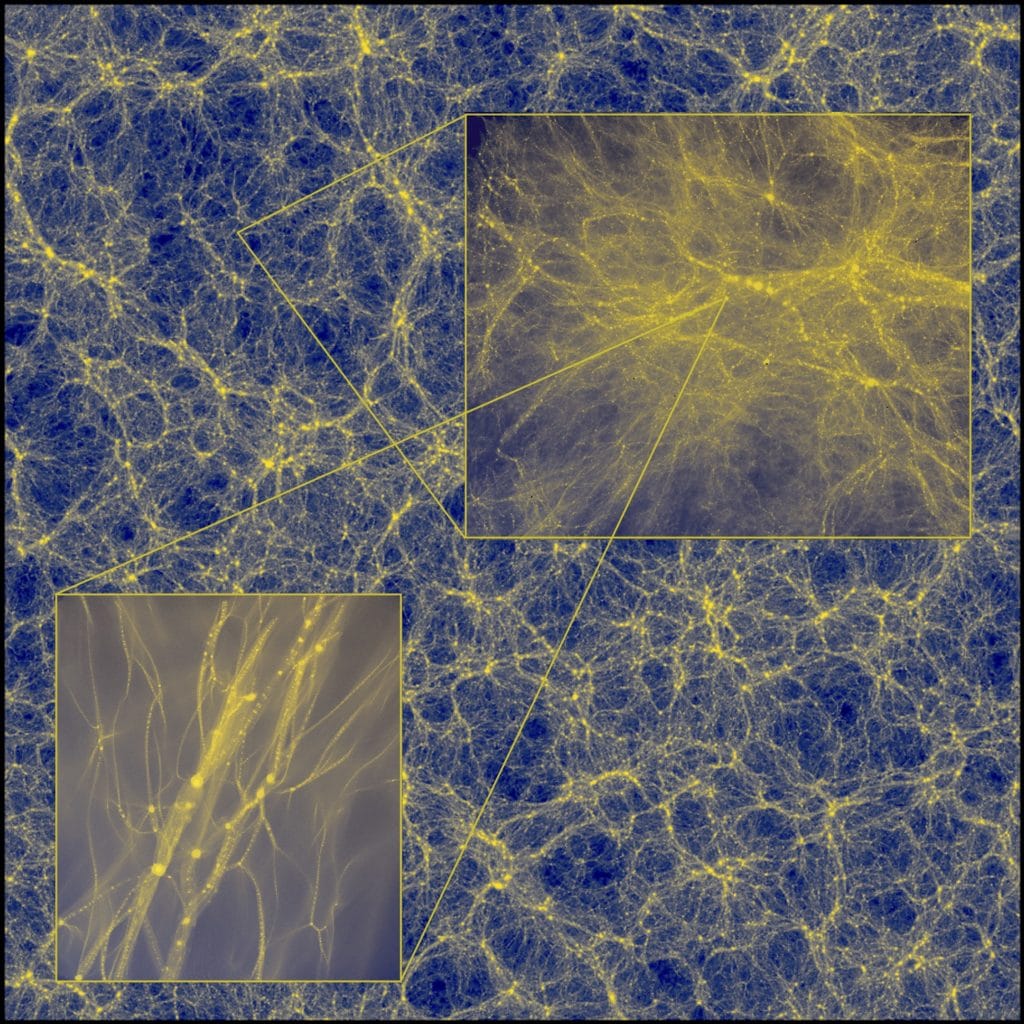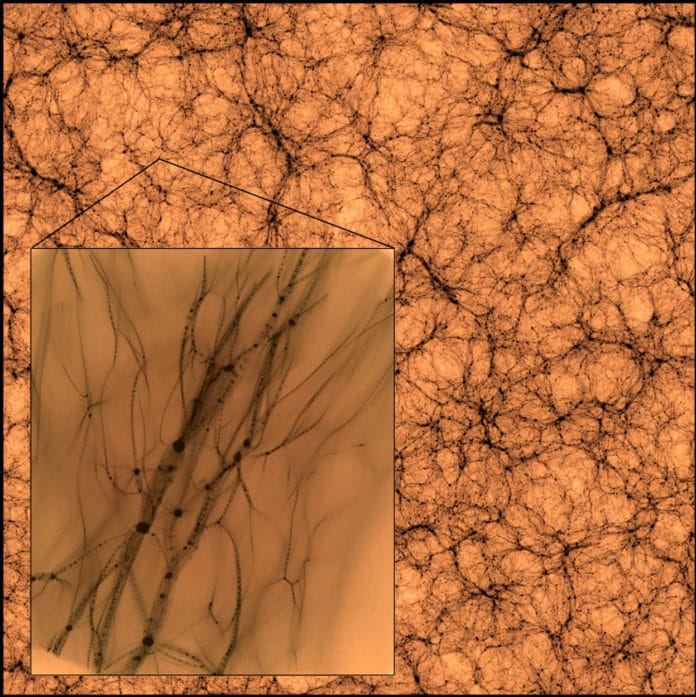Dark matter —which makes up generally 83% of the matter in the Universe—is a significant part in cosmic evolution, including the formation of galaxies, which developed as gas-cooled and condensed at the center of enormous clumps of dark matter. After some time, haloes shaped as some dark matter clumps pulled away from the extension of the Universe because of their enormous gravity.
The largest dark matter haloes contain enormous galaxy clusters—assortments of several galaxies—and keeping in mind that their properties can be construed by contemplating those worlds inside them, the smallest dark matter haloes, which commonly lack even a solitary star, have stayed a secret as of recently.
Cosmological models in which dark matter consists of cold elementary particles predict that the dark halo population should extend to masses many orders of magnitude below those at which galaxies can form.
In a new study, scientists used supercomputers’ power to zoom in on dark matter’s smallest clumps in a virtual universe. Scientists reported a cosmological simulation of the formation of present-day haloes over the full range of observed halo masses (20 orders of magnitude) when dark matter is assumed to be in the form of weakly interacting massive particles of mass approximately 100 gigaelectronvolts.
The simulation has a full dynamic range of 30 orders of magnitude in mass. It resolves hundreds of Earth-mass haloes’ internal structures in as much detail as it does for hundreds of rich galaxy clusters. The study reveals dark matter haloes as active regions of the sky, teeming with not only galaxies but also radiation-emitting collisions that could make it possible to find these haloes in the real sky.

Sownak Bose, a postdoc at the Center for Astrophysics | Harvard & Smithsonian, and one of the lead authors on the research said, “Amongst the things we’ve learned from our simulations is that gravity leads to dark matter particles’ clumping’ in overly dense regions of the Universe, settling into what’s known as dark matter haloes. These can essentially be thought of as big wells of gravity filled with dark matter particles. We think that every galaxy in the cosmos is surrounded by an extended dark matter distribution, which outweighs the galaxy’s luminous material by between a factor of 10-100, depending on the type of galaxy. Because this dark matter surrounds every galaxy in all directions, we refer to it as a ‘halo.'”
The simulation reveals that all dark matter haloes, whether large or small, have very similar internal structures dense at the center and become increasingly diffuse moving outward. Without a scale-bar, it is almost impossible to tell the difference between the dark matter halo of a massive galaxy—up to 10^15 solar masses—and that of a halo with less than a solar mass—down to 10^-6 solar masses.
Jie Wang, an astronomer at the National Astronomical Observatories (NAOC) in Beijing, and a lead author on the research said, “Several previous studies suggested that the density profiles for super-mini haloes would be quite different from their massive counterparts. Our simulations show that they look similar across a huge mass range of dark haloes, which is surprising.”
Bose said, “even in the smallest haloes which do not surround galaxies, our simulations enabled us to visualize the so-called ‘cosmic web.’ Where filaments of dark matter intersect, one sees the tiny, near-spherical blobs of dark matter, which are the haloes themselves, and they are so universal in a structure that I could show you a picture of a galaxy cluster with a million billion times the mass of the Sun, and an Earth-mass halo at a million times smaller than the Sun, and you would not be able to tell which is which.”
During the investigation, specialists tried an element of dark matter haloes that may make them simpler to discover in the real night sky: particle collisions. The current hypothesis proposes that dark matter particles that collide near the center of haloes may explode in a violent burst of high-energy gamma radiation, possibly making the dark matter haloes perceptible by gamma-ray and different telescopes.
Bose said, “Exactly how the radiation would be detected depends on the precise properties of the dark matter particle. In the case of weakly interacting massive particles (WIMPs), which are amongst the leading candidates in the standard cold dark matter picture, gamma radiation is typically produced in the GeV range. There have been claims of a galactic center excess of GeV-scale gamma radiation in Fermi data, which could be due to dark matter or perhaps due to pulsars.”
“Ground-based telescopes like the Very Energetic Radiation Imaging Telescope Array System (VERITAS) can be used for this purpose, too. And, pointing telescopes at galaxies other than our own could also help, as this radiation should be produced in all dark matter haloes.” Wang added, “With the knowledge from our simulation, we can evaluate many different tools to detect haloes—gamma-ray, gravitational lensing, dynamics. These methods are all promising work to shed light on dark matter particles’ nature.”
“The results of the study provide a pathway both for current and future researchers to better understand what’s out there, whether we can see it or not. Understanding the nature of dark matter is one of the Holy Grails of cosmology. While we know that it dominates the gravity of the Universe, we know very little about its fundamental properties: how heavy an individual particle is, what sorts of interactions, if any, it has with ordinary matter, etcetera.”
Journal Reference:
- Wang, J., Bose, S., Frenk, C.S., et al. Universal structure of dark matter haloes over a mass range of 20 orders of magnitude. Nature 585, 39–42 (2020). DOI: 10.1038/s41586-020-2642-9
